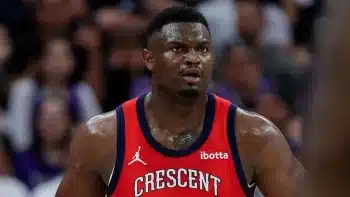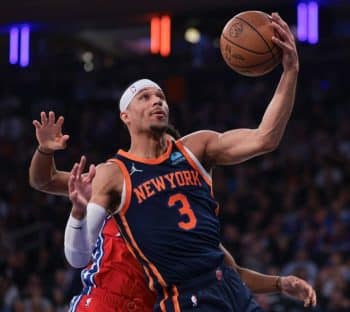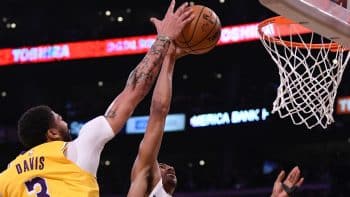NBA
NBA PM: The Joy of Stats

Fifty years ago, NBA teams could not have cared less about statistical trends, especially those of an advanced nature. But in our more modern understanding of the game of basketball and the myriad numbers that come with that modern game, we now know that looking at statistics is an integral part of running a successful team. Every organization in the league has employees whose job is to look at and consider all these numbers and how they might be used to improve the quality of a team.
Sometimes, though, statistics can be flat-out fun. David Beaudoin, a statistics professor at Laval University in Quebec City, Canada, has spent months pouring over data to find the answers to what are some really interesting questions. His analysis considers the last fourteen NBA seasons (not including the current one) to determine things like which teams have been the most “clutch” over time, and whether league parity has increased or decreased since the turn of the century. The questions are important ones, and the answers are both fascinating and even downright entertaining in some instances.
Who Are the Most and Least “Clutch” Teams?
Everybody loves a close game, mostly because of the drama that is associated with the moment, but is there really as much drama as we think? According to the numbers, there are some teams that are significantly better during tight games, and in looking at the data from the last 14 years, it probably won’t come as a huge surprise which teams were best at owning the moment.
In games where the margin of victory ended up being three points or fewer, or if the game went into overtime, the San Antonio Spurs have the best winning percentage of any team in the league at 62.0 percent. The Dallas Mavericks (57.6 percent) and L.A. Lakers (56.2 percent) round out the top three. But the fourth-best “clutch” winning percentage in the league is a bit surprising: the New Orleans Pelicans/Hornets (55.8 percent).
The least effective teams in tight games include the Minnesota Timberwolves (40.7 percent), Toronto Raptors (42.9 percent) and New York Knicks (43.7 percent).
To find the real surprises in this analysis, however, it was necessary to compare these “clutch” win percentages against actual overall team winning percentages. When doing that. Charlotte (+10.6 percent), Brooklyn/New Jersey (+10.0 percent) and New Orleans (+9.1 percent) were the teams that were actually better in tight games than their record would suggest. The Phoenix Suns (-9.0 percent), Golden State Warriors (-6.4 percent) and Indiana Pacers (-5.0 percent) were actually worse in close games than their regular season record.
Also, in the last 14 years, only one team, the 2013-2014 San Antonio Spurs, has won all of its “close” games in a season, while only the 2015-2016 Philadelphia 76ers have ever gone an entire season without winning a single close game. Those, officially, are the most and least clutch teams of the millennium so far.
Which Teams Have Made the Most Comebacks?
The team that scores the first points in the game doesn’t always win the game, naturally. Basketball is a game of back-and-forth, and deficits don’t necessarily mean that a team is buried. Take the San Antonio Spurs’ recent 28-point comeback against the Sacramento Kings, for example. No team is ever completely out of the woods until the final horn sounds.
Some teams though, including the Spurs, are more adept at comebacks than others. In fact, all three Texas teams hold the top spots on the list of organizations with the most comebacks over the last 14 seasons.
Naturally, San Antonio has been the best, and their ability to comeback is frankly staggering. When trailing after the first quarter, all NBA teams have a comeback proportion between 24 percent and 48.1 percent. San Antonio, however, approaches a 59 percent probability of winning when trailing after one period.
Understandably, the number of wins when trailing after three quarters decreases considerably. The Spurs are still the top team in this regard, with a comeback percentage of 27.7 percent when trailing heading into the final period, but only nine teams consistently win 20 percent or more of games when they’re trailing after three: San Antonio, Dallas, Cleveland, Portland, Houston, Miami, Boston, Los Angeles Lakers and Chicago.
Cleveland, ranked 10th and 16th in comeback percentage after one quarter and two quarters, respectively, jumps to third overall when trailing after three quarters. There’s a good chance that LeBron James and Kyrie Irving have something to do with that.
Has League Parity Increased or Decreased?
That there have been seven different organizations win the NBA championship in the last nine years suggests that league parity isn’t a problem, but data trends suggest that there actually has been a decrease in parity over the course of the last 14 years. In other words, it’s only getting easier for the good teams and harder for the bad ones, and despite all these different champions, the playing field isn’t as even as it some would hope.
The number of teams with a record around .500 in a given season has been decreasing, specifically over the last nine seasons. From 2002 through 2007, league parity actually appeared to be on the rise, a conclusion that can be drawn by considering that, earlier on in the study, there were more teams around .500 and fewer teams with very good or very bad records.
In the more recent NBA past, that has changed. Furthermore, the study claims that a decrease in parity would suggest fewer comebacks, since more teams matching up more evenly would experience closer games, but average comeback percentages have been decreasing steadily over the past nine seasons. Fewer teams are coming back to win games, which suggests that those exciting, close games are happening less often.
The rich are getting richer, and the poor are getting poorer, but that passes the eye test, as well. Fans have complained about parity for years now, and the numbers suggest they may have a legitimate gripe.
Does “Momentum” Really Exist in Games?
The last question is a great one because every sports fan has watched a game and seen momentum shift right in the middle of a game. After trailing, a player or two will get hot and knock down a handful of shots in a row. The home crowd gets into it, and before we know it, it’s like we’re watching a completely different game. That switch flips on and off several times in just about every game played in the NBA.
But do the numbers suggest that momentum actually is a real thing?
Of course it is, but it may be contained to a single quarter. Coaches call timeouts to shut down a run for a reason, and the longer, more official breaks in action really do seem to shut down any momentum a team may experience in a quarter.
In looking at the halftime scores, the idea would be that if a home team outscored its opponents by six or more points in the most recent quarter, they’d have the momentum in the game. However, the numbers suggest that the home team actually wins more often when the road team had that measure of momentum in the 2nd quarter.
In other words, momentum is a thing, but it may not have the outcome on winning that we think it does, especially if those runs happen earlier on in the game.
*****
Chances are very good that the data from the 2016-2017 season would alter some of these findings somewhat, but as only 1/15th of the number pool they likely wouldn’t change the overall trends. Parity is decreasing, momentum doesn’t matter, and the San Antonio Spurs are awesome in yet another measurable way. We have stats to thank for all that.











